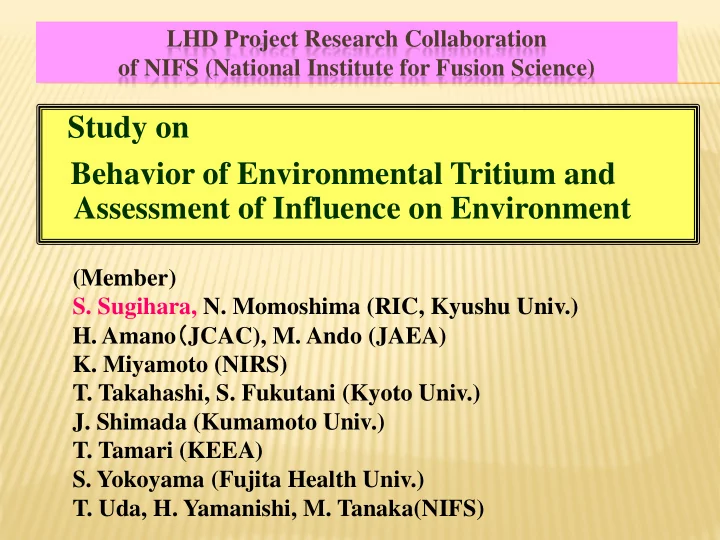

LHD Project Research Collaboration of NIFS (National Institute for Fusion Science) Study on Behavior of Environmental Tritium and Assessment of Influence on Environment (Member) S. Sugihara, N. Momoshima (RIC, Kyushu Univ.) H. Amano ( JCAC), M. Ando (JAEA) K. Miyamoto (NIRS) T. Takahashi, S. Fukutani (Kyoto Univ.) J. Shimada (Kumamoto Univ.) T. Tamari (KEEA) S. Yokoyama (Fujita Health Univ.) T. Uda, H. Yamanishi, M. Tanaka(NIFS)
NATIONAL INSTITUTE FOR FUSION SCIENCE NIFS The NIFS is engaged in basic research in fusion plasma in order to create the sun on earth and to actualize nuclear fusion generation, which generates new source of energy that is safe and environmentally friendly. LHD building Major axes in the research Physical research regarding generation and confinement of high temperature, high density plasmas with using superconducting Large Helical Device, LHD Simulation science research using super computer Engineering research for fusion reactor Safety and environmental research.
BACKGROUND Although Nuclear fusion facilities, such as ITER, are 1. expected to require about 2000 PBq of tritium for their “fuel”, only a small part of these tritium may be released from the facilities. Nuclear fusion plant (核融合炉) D ( 2 H) : T ( 3 H) → neutron (14MeV) + 4 He ↓ n : Li → T ( 3 H) In the D-D experiment which NIFS plans, the tritium of 55.5 1. GBq/year will be produced. NIFS plans a tritium release to the environment to become below 3.7 GBq / year. It is necessary to guarantee the safety of released tritium. 1. To understand the tritium behavior in the environment, To show that there is not a significant increase of individual dose To send the safe and relieved information to the public.
Subjects that we are focusing on: 1) Behavior of Environmental Tritium 2) Assessment of Influence on Environment Because the tritium concentration of the environment level is about 1 Bq/l in Japan, to see a significant difference, we need high- precision measurement. METHODS (1) water sample ・・ 2L (2) distillation twice (3) enrichment with an electrolytic enrichment system (XZ001-1, and XZ001-2, Permelec electrode Ltd.) enrichment factor of 8.18 and 8.01 times 1000ml → 60ml (4)LSC counting (LB-5, Aloka Ltd.) 50 ml of the enriched water + 50 ml of scintillation cocktail ( Ultima GOLDTM LLT, Perkin Elmer ) in a Teflon vial.
Compartment model (former) Downstream Network of River year estimate → each rain event The improvement of the model Spread out to the vertical direction.
COMPARTMENT MODEL 3 H, 2 H, 18 18 O Rain Rain Cond onducti tivit ity Bypas ass o or Su Surfac ace f flo low Evaporation Shallo llower G r GW Transpiration River W Riv r Wat ater Deep eeper er GW Reservoir ir s siz ize Reside idence ce T Tim ime Cat atch chment A Area ea Siz ize
Tritium Activity ( Bq/l ) Fig. 1 Tritium Activity in rain at NIFS site (07/06/25 - 08/10/31) 0.1 0.2 0.3 0.4 0.5 0.6 0.7 0.8 07/06/25- 07/07/09- 07/07/13- 07/07/17- 07/07/30- 07/08/31- 07/09/12- 07/09/28- 07/10/17- 07/11/07- T Activity 07/12/04- 07/12/28- 08/01/18- 08/02/04- 08/02/29- 08/03/21- 08/04/07- 08/04/11- 08/04/28- 08/05/16- 08/05/26- 08/06/04- 08/06/23- 08/08/01- 08/08/25- 08/08/29- rainfall 08/09/16- 08/09/24- 08/10/01- 100 150 200 50 0 Rainfall ( mm )
Tritium Activity ( Bq/l ) 0.1 0.2 0.3 0.4 0.5 0.6 0.7 0.8 07/06/25- 07/07/09- 07/07/13- 07/07/17- 07/07/30- 07/08/31- 07/09/12- 07/09/28- 07/10/17- 07/11/07- 07/12/04- 07/12/28- 08/01/18- 08/02/04- 08/02/29- 08/03/21- 08/04/07- 08/04/11- 08/04/28- 08/05/16- 08/05/26- 08/06/04- 08/06/23- 08/08/01- Toki river R-15 R-10 T Activity 08/08/25- 08/08/29- 08/09/16- 08/09/24- 08/10/01-
δ 18 O( ‰ ) δD( ‰ )
The relationship between the oxygen isotopic-ratio and the conductivity (Measurement of 1 hour by hour in case of the rainfall) Example Rainfall Rain Conductivity 18 O GW GW Rain
Separation of outflow component Q:outflow C:concentration of tracer t : total g : groundwater d : direct flow = + Q Q Q (1) t g d mass balance equation of tracer = + Q C Q C Q C (2) t t g g d d from (1) and (2) − C C = t d Q Q (3) − g t C C g d
The example of the component separation by the oxygen isotopic-ratio 降水 Direct flow GW 佐野地下水
COMPARTMENT MODEL 3 H, 2 H, 18 18 O Rain Rain Cond onducti tivit ity Washout Bypas ass o or Su Surfac ace f flo low Evaporation Shallo llower G r GW Transpiration River W Riv r Wat ater Deep eeper er GW Movement to Reservoir ir s siz ize deeper soil layer Reside idence ce T Tim ime Cat atch chment A Area ea Siz ize
THANK YOU VERY MUCH FOR YOUR KIND ATTENTION Acknowledgement This work is supported by NIFS/NINS under the project of Formation of International Network for Scientific Collaborations.
Recommend
More recommend